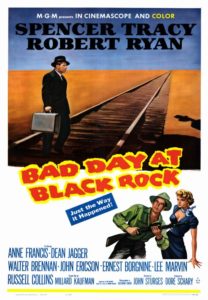Suddenly you realize murder is at your elbow! – and there’s no way out!
Based on Howard Breslin’s Bad Day at Hondo, the 1955 film Bad Day at Black Rock is often wedged into the Western genre. Honda was undoubtedly changed to Bad Rock as a result of the contemporary John Wayne film “Hondo,” released two years prior in 1953. Though truth be told the similarities are rather few.
Rather, in Spencer Tracy’s last film with MGM, we see the studio pulling out all the stops. In addition to Tracy, the stellar cast is chock full of heavy hitters, including Ernest Borgnine,
Robert Ryan, Lee Marvin, and Walter Brennan. We also get the fine and crisp directorial stylings of John Sturges. Bad Day at Black Rock also benefits from Cinemascope, as there are plenty of open spaces. Especially well done are the numerous shots of this little town of seven or eight little buildings sitting in the middle of nowhere before the mountains in the not so far distance.
The film, with a tight and concise run time of a mere 81 minutes, manages to cram a tremendous amount into little more than an hour. Tracy is World War Two veteran John Macreedy, a names that somehow sounds as craggy and indomitable as the actor himself.
Macreedy arrives at Black Rock on the train and immediately draws looks and exceptional levels of attention from the town’s small population. For starters the train hasn’t stopped in Black Rock for four years; and the assumption as the movie continues that few if any have ever come into town by car either. Bus, you say? Well the bus station is 30 miles or so away.
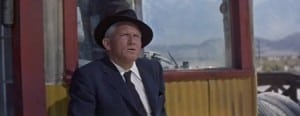 The questions and quizzical looks only grow once Macreedy begins asking about a Japanese-American named Kamoko and how he might get out to Kamoko’s place at a place called Adobe Flats. To further the suspense, no one seems to know Kamoko or where he is. Well, a moment later we realize they know, but aren’t talking. There are a few who clearly feel for Macreedy, but something bigger has a hold over them.
The questions and quizzical looks only grow once Macreedy begins asking about a Japanese-American named Kamoko and how he might get out to Kamoko’s place at a place called Adobe Flats. To further the suspense, no one seems to know Kamoko or where he is. Well, a moment later we realize they know, but aren’t talking. There are a few who clearly feel for Macreedy, but something bigger has a hold over them.
As his brief stay in town continues, Macready finds that all roads lead to rancher Reno Smith, played with usual style by Robert Ryan. Though Reno holds no official title, he is clearly the boss; even the sheriff is firmly in his hand. Reno too has an all star gang, headed by Ernest Borgnine and Lee Marvin.
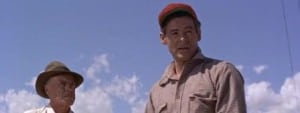 Both Borgnine and Marvin have their moments in the sun, with Marvin’s best scene occurring later in the film when he is suddenly made sheriff. Marvin taunts Tracy, verbally abusing him in a sinisterly gentle way, while he slowly shreds Macreedy’s unsent telegram.
Both Borgnine and Marvin have their moments in the sun, with Marvin’s best scene occurring later in the film when he is suddenly made sheriff. Marvin taunts Tracy, verbally abusing him in a sinisterly gentle way, while he slowly shreds Macreedy’s unsent telegram.
Borgnine gets two strong scenes, with perhaps my favorite being as he chases Macreedy back from Adobe Flats. Borgnine cackles like a mad hyena as he tries to force him off the road and off the side of the mountain.
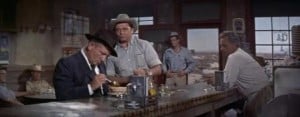 Borgnine’s second big scene is much more sinister, as he constantly harangues Macreedy in what serves for a diner in little Black Rock. It is here that Tracy, long appearing to be a kindly and perhaps even dottering man, lets loose.
Borgnine’s second big scene is much more sinister, as he constantly harangues Macreedy in what serves for a diner in little Black Rock. It is here that Tracy, long appearing to be a kindly and perhaps even dottering man, lets loose.
Using karate- or perhaps more likely judo, the cagey veteran beats the tar out of Borgnine. And he does it one handed seeing that his one arm is useless as a result of a war injury sustained in Italy.
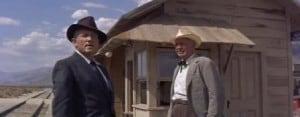 The film was always Tracy’s but it is worth mentioning again that his presence on screen is intimidating beyond compare. Whenever he is on screen he holds your attention. Throughout the film he seems tired and haggard, and often speaks in only a whisper. There are no long speeches from the man and he chooses his words sparingly. It is a real treat to see how much of the abuse that is heaped upon him simply washes off his back.
The film was always Tracy’s but it is worth mentioning again that his presence on screen is intimidating beyond compare. Whenever he is on screen he holds your attention. Throughout the film he seems tired and haggard, and often speaks in only a whisper. There are no long speeches from the man and he chooses his words sparingly. It is a real treat to see how much of the abuse that is heaped upon him simply washes off his back.
In light of the current Donald Sterling debacle, the handling of race in this picture is also needing a mention. Over time the truth comes out that Reno killed Kamoko is a hate filled racist rage. Evidently Reno was refused enlistment after Pearl Harbor. His already poor opinion of the Japanese was further exacerbated that Kamoko got the better of him in a land deal. Reno felt he was ‘sticking it’ to Kamoko in renting him a desolate and arid piece of property, only to be flabbergasted by Kamoko’s ingenuity and resourcefulness in drilling a well for the much needed water his homestead would require. It is nice to see the nice tie-in back to Japanese culture when Macreedy uses the martial arts in his fight with Borgnine.
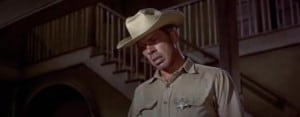 Overall this is a powerful story of the power of cowardice, backward thinking, and inner growth. By the end of the picture- which takes place over the course of roughly twenty four hours, Tracy has converted the town back to the straight and narrow. Several of the previously meek and beaten townspeople have risen above their shameful deference to Reno to make their own opinions.
Overall this is a powerful story of the power of cowardice, backward thinking, and inner growth. By the end of the picture- which takes place over the course of roughly twenty four hours, Tracy has converted the town back to the straight and narrow. Several of the previously meek and beaten townspeople have risen above their shameful deference to Reno to make their own opinions.
For all that is good and in spots great about Bad Day at Black Rock, it isn’t perfect. The run time which so brilliantly drives suspense and momentum towards the climactic conclusion does so at the expense of characterization. There is little time or effort spent trying to show who these people are or why they are as such. Only Reno gets the slightest touch and that is clearly required by the plot.
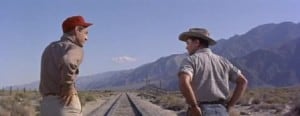 The other flaw in the film is Andre Previn and his atrocious score. Perhaps Tiomkin would have been better (he is usually the best with those wide open spaces), but Previn’s score is a dissonant mess. Every time there is a key plot point or a moment where the suspense is about to break you, don’t worry as Previn lets you know something is coming. Let’s end and just say subtlety isn’t his style.
The other flaw in the film is Andre Previn and his atrocious score. Perhaps Tiomkin would have been better (he is usually the best with those wide open spaces), but Previn’s score is a dissonant mess. Every time there is a key plot point or a moment where the suspense is about to break you, don’t worry as Previn lets you know something is coming. Let’s end and just say subtlety isn’t his style.
In spite of the negatives- the first of which at least borders on nitpicking- Bad Day at Black Rock is a great reminder of how movies used to be and features a great cast melding the Golden and Silver ages of Hollywood.
